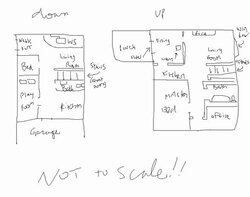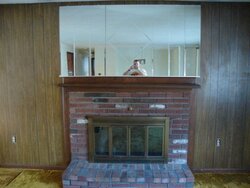5. Any tips on most efficient/productive burning, lighting, wood usage, etc?
The stove is a side loader, and burns from the door towards the end of the stove on a consistent basis. I have NEVER run the stove with the “rollup” door open, so all this refers to how it works with the door closed.
I process my own wood, so I have a large supply of small stuff (I burn anything over about 1/2" diameter...) and what I call my "magic starter stuff" which is all the fragments of bark and chips that I rake up from around my splitting area.
I start the fire by opening the stack damper, closing the upper spin damper, and opening the bottom one. I roll up and crumple newspaper into several "spears" that I lay along the length of the stove. I throw several handfuls of my "starter stuff" on top, followed by some kindling size sticks, and then smaller splits - Note, optimum split length for the Pro-Former is 24-26" - shorter wood will work, but you waste a lot of the firebox capacity. If I have room I may get a couple medium splits on top - I want the firebox pretty well stuffed. Push all the splits as far in as you can. If I don't have plenty of newspaper visible, I may ball up one or two more sheets, put them in with a bit more "starter stuff" on top. I light the paper in two or three places then close the door. The bottom spin damper creates an air jet into the bottom of the firebox and will get everything going within 10-15 minutes. As soon as the stove is up to temp, I mostly close the bottom spin damper, and open the top one most of the way, then regulate the burn with the stack damper.
Refueling, I open the stack damper all the way first, then close the upper spin damper and open the door. I shovel the bulk of the ashes out of the 1/3 to 1/2 of the stove closest to the door - use an ash bucket, and stop when you get to the point where there are lots of coals as opposed to ashes. I then use a coal rake to pull as much of the coals, unburned wood and ash towards the door as I can. I want to end up with a slope of coals, ash, etc. ranging from less than 1/2" at the left end of the stove to just below the level of the door on the right. I then stuff the firebox with splits, again trying to get them as far in as I can, close the door, and open the top spin damper - if the fire is low I may open the bottom spinner instead, like I was starting the stove. If it's looking close to out, I'll throw several handfuls of "starter stuff" in before loading splits, and again open the bottom spinner until the fire is going well, then (again) shift over to the top spinner, and close the stack damper to regulate the fire.
The basic idea is that once the fire is going well, you want a total spin damper opening of 30-50% of ONE damper's worth, that you manage as a ratio, as you close one you open the other...
The stove is sensitive to leaks, get a tub of refractory cement, and make sure to seal up any joints in the pipe and leaks between the stove and the chimney.
You will need to clean the chimney fairly regularly, as I note in my sig, this IS a Pre-EPA "smoke dragon" and will generate lots of creosote... If you start getting smoke out the upper spin damper when the bottom damper is closed, then it is probably past due. Indeed I'd suggest that if you can afford to, it is a good idea to replace the stove with a more efficient modern stove. You will burn cleaner, get more heat from a given amount of wood, and not have to clean the chimney as often.... In fact I'm in the process of replacing my Pro-Former with a VC Encore cat stove, and am looking forward to NOT having to deal with the smoke dragon next season.
Any tips or suggestions (especially on the following) would be great!
-Quickest fire starting method
See above, the same technique should work well in your fireplace as well.
More is better, it doesn't spoil, and I suspect that once you get your first electric heat bill you will start burning a whole lot more! Note that once the burning season starts, it's to late to process your own, and good seasoned cut & split is hard to come by and expensive. Stock up now and beat the rush. (FWIW, burning 24/7 near Lowell, MA I go through 5-6 cords)
Get the appropriate size brush for your chimney, along with enough length in rods (I use 1/2" pvc electrical conduit and some pipe fittings to make my own, at a tiny fraction of what they charge for the "official" rods) and figure out your best approach for cleaning, probably from the bottom as you WILL need to clean mid-season and it isn't safe to go on a snowy roof if you can avoid it!
Use well seasoned good quality wood (i.e. OAK) in largish splits, and stuff the firebox. Note that long burns are going to be your dirtiest burns, because the only way to make the Pro-Former burn slow is to choke it down.
-Fireplace usage: glass doors open/closed?
experiment to find out, but probably closed.
What are the pins on the top and bottom of the surround that I can pull in/out?
The knob in the top center above the surround looks like your damper, not sure about the other pins, could be something to control air venting from the room into the fireplace, or possibly if that door set is intended to be a sort of heatilator type thing, could control the heat outlet flow. You probably just need to experiment - wiggle the pins and see what they're connected to.
Keep wood holder thingie?
I'm assuming you are referring to the grate for the fireplace? If so, yes.
Good Luck,
Gooserider



